Charlotte Muth
Neural Network-Based Single-Carrier Joint Communication and Sensing: Loss Design, Constellation Shaping and Precoding
Sep 30, 2025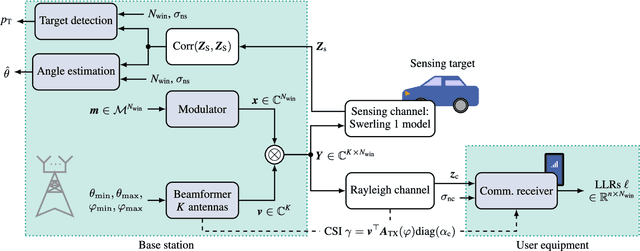

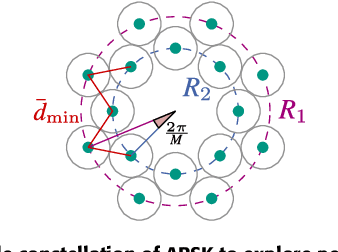
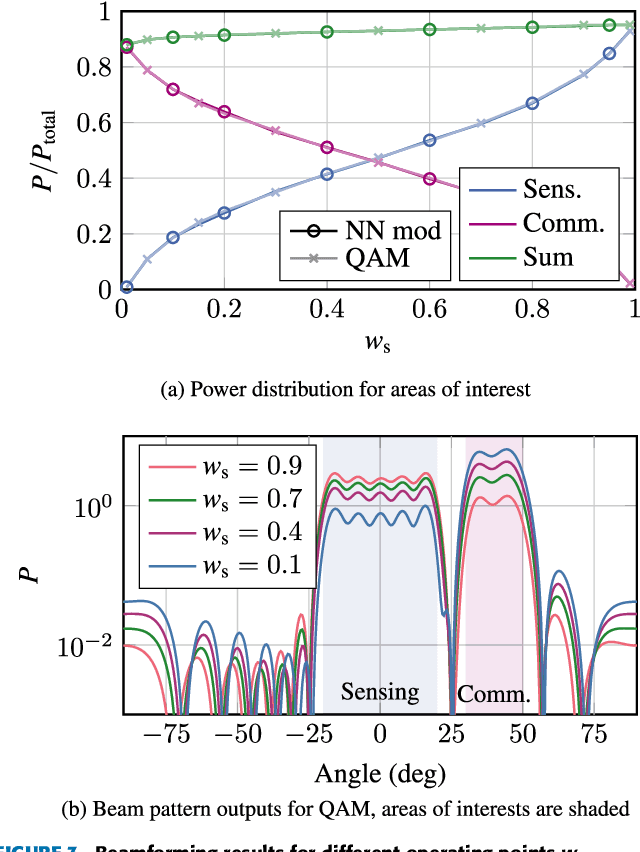
Abstract:We investigate the impact of higher-order modulation formats on the sensing performance of single-carrier joint communication and sensing (JCAS) systems. Several separate components such as a beamformer, a modulator, a target detector, an angle of arrival (AoA) estimator and a communication demapper are implemented as trainable neural networks (NNs). We compare geometrically shaped modulation formats to a classical quadrature amplitude modulation (QAM) scheme. We assess the influence of multi-snapshot sensing and varying signal-to-noise ratio (SNR) on the overall performance of the autoencoder-based system. To improve the training behavior of the system, we decouple the loss functions from the respective SNR values and the number of sensing snapshots, using upper bounds of the sensing and communication performance, namely the Cram\'er-Rao bound for AoA estimation and the mutual information for communication. The NN-based sensing outperforms classical algorithms, such as a Neyman-Pearson based power detector for object detection and ESPRIT for AoA estimation for both the trained constellations and QAM at low SNRs. We show that the gap in sensing performance between classical and shaped modulation formats can be significantly reduced through multi-snapshot sensing. Lastly, we demonstrate system extension to multi-user multiple-input multiple-output to address the improvement of spatial efficiency when servicing multiple user equipments. Our contribution emphasizes the importance of estimation bounds for training neural networks, especially when the trained solutions are deployed in varying SNR conditions.
* Published in IEEE Access Source code available at https://github.com/frozenhairdryer/JCAS-loss-shape-precode
Constellation Shaping for OFDM-ISAC Systems: From Theoretical Bounds to Practical Implementation
Sep 04, 2025
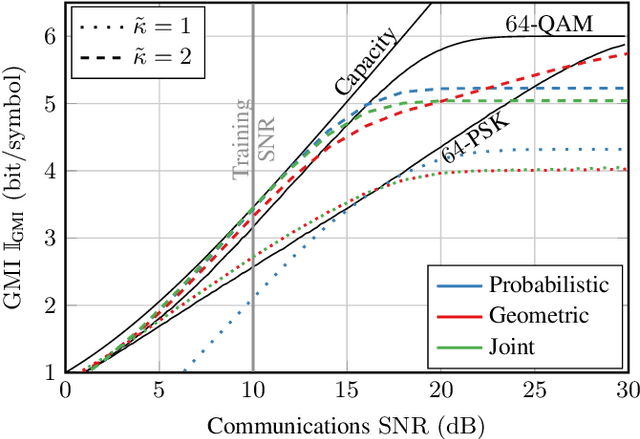
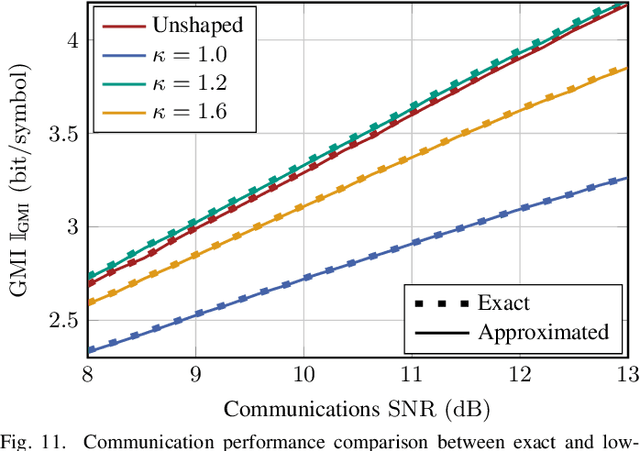
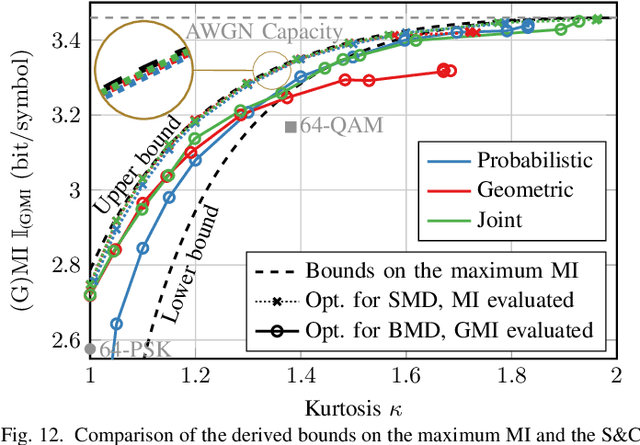
Abstract:Integrated sensing and communications (ISAC) promises new use cases for mobile communication systems by reusing the communication signal for radar-like sensing. However, sensing and communications (S&C) impose conflicting requirements on the modulation format, resulting in a tradeoff between their corresponding performance. This paper investigates constellation shaping as a means to simultaneously improve S&C performance in orthogonal frequency division multiplexing (OFDM)-based ISAC systems. We begin by deriving how the transmit symbols affect detection performance and derive theoretical lower and upper bounds on the maximum achievable information rate under a given sensing constraint. Using an autoencoder-based optimization, we investigate geometric, probabilistic, and joint constellation shaping, where joint shaping combines both approaches, employing both optimal maximum a-posteriori decoding and practical bit-metric decoding. Our results show that constellation shaping enables a flexible trade-off between S&C, can approach the derived upper bound, and significantly outperforms conventional modulation formats. Motivated by its practical implementation feasibility, we review probabilistic amplitude shaping (PAS) and propose a generalization tailored to ISAC. For this generalization, we propose a low-complexity log-likelihood ratio computation with negligible rate loss. We demonstrate that combining conventional and generalized PAS enables a flexible and low-complexity tradeoff between S&C, closely approaching the performance of joint constellation shaping.
Uncertainty Propagation in the Fast Fourier Transform
Apr 14, 2025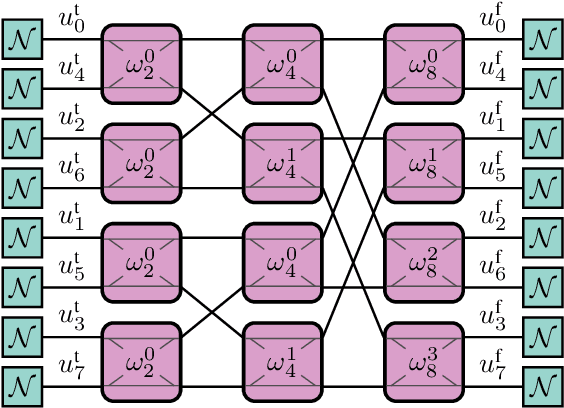

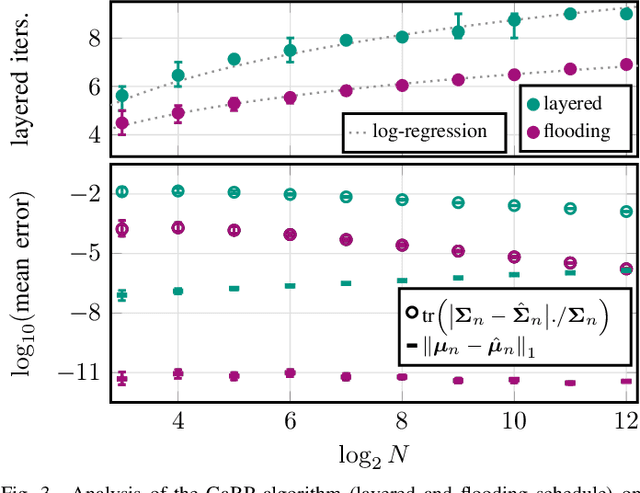
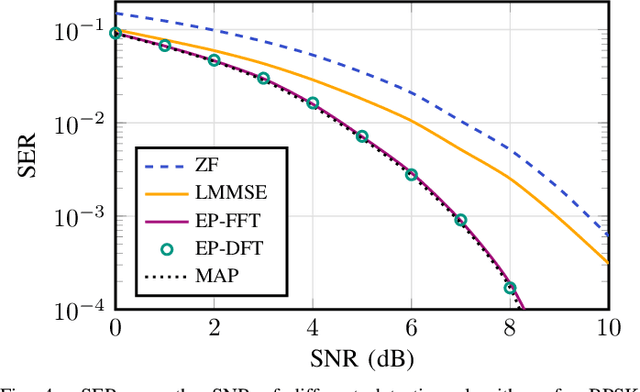
Abstract:We address the problem of uncertainty propagation in the discrete Fourier transform by modeling the fast Fourier transform as a factor graph. Building on this representation, we propose an efficient framework for approximate Bayesian inference using belief propagation (BP) and expectation propagation, extending its applicability beyond Gaussian assumptions. By leveraging an appropriate BP message representation and a suitable schedule, our method achieves stable convergence with accurate mean and variance estimates. Numerical experiments in representative scenarios from communications demonstrate the practical potential of the proposed framework for uncertainty-aware inference in probabilistic systems operating across both time and frequency domain.
On the Sensing Performance of FMCW-based Integrated Sensing and Communications with Arbitrary Constellations
Mar 21, 2025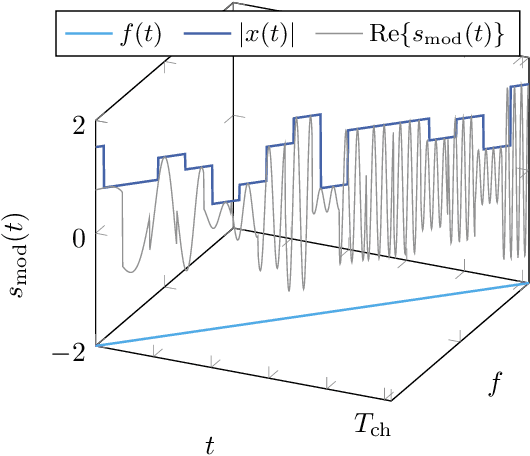
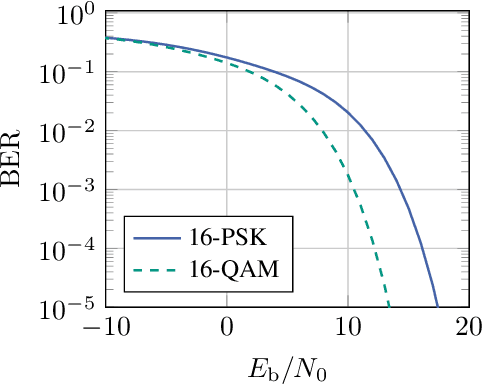

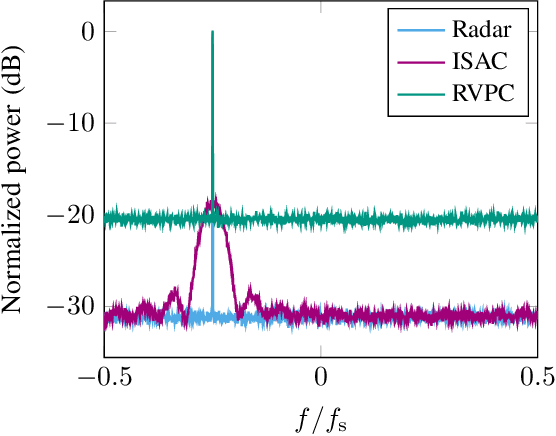
Abstract:Integrated sensing and communications (ISAC) is expected to play a major role in numerous future applications, e.g., smart cities. Leveraging native radar signals like the frequency modulated continuous wave (FMCW) waveform additionally for data transmission offers a highly efficient use of valuable physical radio frequency (RF) resources allocated for automotive radar applications. In this paper, we propose the adoption of higher-order modulation formats for data modulation onto an FMCW waveform and provide a comprehensive overview of the entire signal processing chain. We evaluate the impact of each component on the overall sensing performance. While alignment algorithms are essential for removing the information signal at the sensing receiver, they also introduce significant dispersion to the received signal. We analyze this effect in detail. Notably, we demonstrate that the impact of non-constant amplitude modulation on sensing performance is statistically negligible when the complete signal processing chain is considered. This finding highlights the potential for achieving high data rates in FMCW-ISAC systems without compromising the sensing capabilities.
Integrated Long-range Sensing and Communications in Multi Target Scenarios using CP-OFDM
Jan 20, 2025Abstract:6G communication systems promise to deliver sensing capabilities by utilizing the orthogonal frequency division multiplexing (OFDM) communication signal for sensing. However, the cyclic prefix inherent in OFDM systems limits the sensing range, necessitating compensation techniques to detect small, distant targets like drones. In this paper, we show that state-of-the-art coherent compensation methods fail in scenarios involving multiple targets, resulting in an increased noise floor in the radar image. Our contributions include a novel multi target coherent compensation algorithm and a generalized signal-to-interference-and-noise ratio for multiple targets to evaluate the performance. Our algorithm achieves the same detection performance at long distances requiring only 3.6% of the radio resources compared to classical OFDM radar processing. This enables resource efficient sensing at long distances in multi target scenarios with legacy communications-only networks.
Resolution Improvement in OFDM-based Joint Communication and Sensing through Combined Tracking and Interpolation
Nov 19, 2024Abstract:We investigate a monostatic orthogonal frequency-division multiplexing (OFDM)-based joint communication and sensing (JCAS) system with multiple antennas for object tracking. The native resolution of OFDM sensing, and radar sensing in general, is limited by the observation time and bandwidth. In this work, we improve the resolution through interpolation methods and tracking algorithms. We verify the resolution enhancement by comparing the root mean squared error (RMSE) of the estimated range, velocity and angle and by comparing the mean Euclidean distance between the estimated and true position. We demonstrate how both a Kalman filter for tracking, and interpolation methods using zero-padding and the chirp Z-transform (CZT) improve the estimation error. We discuss the computational complexity of the different methods. We propose the KalmanCZT approach that combines tracking via Kalman filtering and interpolation via the CZT, resulting in a solution with flexible resolution that significantly improves the range RMSE.
Bistatic OFDM-based ISAC with Over-the-Air Synchronization: System Concept and Performance Analysis
May 08, 2024



Abstract:Integrated sensing and communication (ISAC) has been defined as one goal for 6G mobile communication systems. In this context, this article introduces a bistatic ISAC system based on orthogonal frequency-division multiplexing (OFDM). While the bistatic architecture brings advantages such as not demanding full duplex operation with respect to the monostatic one, the need for synchronizing transmitter and receiver is imposed. In this context, this article introuces a bistatic ISAC signal processing framework where an incoming OFDM-based ISAC signal undergoes over-the-air synchronization based on preamble symbols and pilots. Afterwards, bistatic radar processing is performed using either only pilot subcarriers or the full OFDM frame. The latter approach requires estimation of the originally transmitted frame based on communication processing and therefore error-free communication, which can be achieved via appropriate channel coding. The performance and limitations of the introduced system based on both aforementioned approaches are assessed via an analysis of the impact of residual synchronization mismatches and data decoding failures on both communication and radar performances. Finally, the performed analyses are validated by proof-of-concept measurement results.
Loss Design for Single-carrier Joint Communication and Neural Network-based Sensing
Mar 05, 2024Abstract:We evaluate the influence of multi-snapshot sensing and varying signal-to-noise ratio (SNR) on the overall performance of neural network (NN)-based joint communication and sensing (JCAS) systems. To enhance the training behavior, we decouple the loss functions from the respective SNR values and the number of sensing snapshots, using bounds of the sensing performance. Pre-processing is done through conventional sensing signal processing steps on the inputs to the sensing NN. The proposed method outperforms classical algorithms, such as a Neyman-Pearson-based power detector for object detection and ESPRIT for angle of arrival (AoA) estimation for quadrature amplitude modulation (QAM) at low SNRs.
Bistatic OFDM-based Joint Radar-Communication: Synchronization, Data Communication and Sensing
May 24, 2023
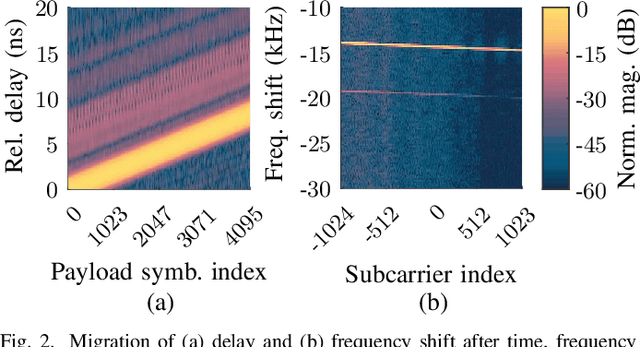

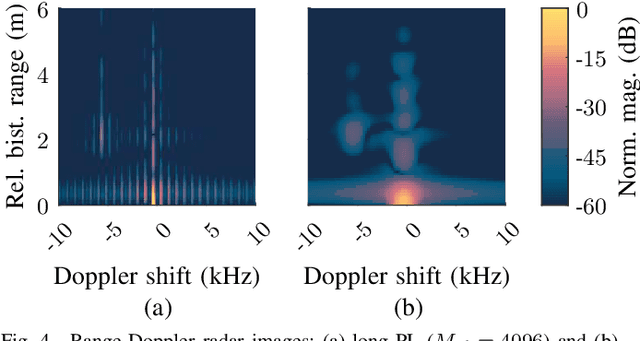
Abstract:This article introduces a bistatic joint radar-communication (RadCom) system based on orthogonal frequency-division multiplexing (OFDM). In this context, the adopted OFDM frame structure is described and system model encompassing time, frequency, and sampling synchronization mismatches between the transmitter and receiver of the bistatic system is outlined. Next, the signal processing approaches for synchronization and communication are discussed, and radar sensing processing approaches using either only pilots or a reconstructed OFDM frame based on the estimated receive communication data are presented. Finally, proof-of-concept measurement results are presented to validate the investigated system and a trade-off between frame size and the performance of the aforementioned processing steps is observed.
Autoencoder-based Joint Communication and Sensing of Multiple Targets
Jan 24, 2023Abstract:We investigate the potential of autoencoders (AEs) for building a joint communication and sensing (JCAS) system that enables communication with one user while detecting multiple radar targets and estimating their positions. Foremost, we develop a suitable encoding scheme for the training of the AE and for targeting a fixed false alarm rate of the target detection during training. We compare this encoding with the classification approach using one-hot encoding for radar target detection. Furthermore, we propose a new training method that complies with possible ambiguities in the target locations. We consider different options for training the detection of multiple targets. We can show that our proposed approach based on permuting and sorting can enhance the angle estimation performance so that single snapshot estimations with a low standard deviation become possible. We outperform an ESPRIT benchmark for small numbers of measurement samples.
 Add to Chrome
Add to Chrome Add to Firefox
Add to Firefox Add to Edge
Add to Edge